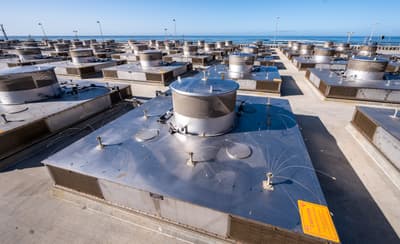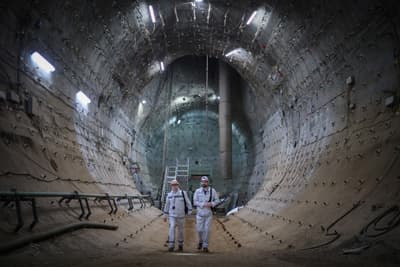Recycling nuclear waste is probably the single biggest point of contention among people who otherwise support nuclear power.
It sounds like a win-win, as sensible as putting our aluminum cans in the bins with chasing arrows. And as interest in nuclear energy has grown in recent years — driven by climate concerns and, more recently, demand from energy-intensive data centers — so has enthusiasm in some quarters for recycling this waste stream. Late last year, the Department of Energy announced $10 million in funding for research on recycling technologies and at least two relevant bipartisan bills were introduced in Congress: one would “require the Secretary of Energy to study new technologies and opportunities for recycling spent nuclear fuel”; another would streamline licensing requirements for recycling facilities.
Several advanced nuclear startups, including Oklo and Curio, say they intend to run their reactors exclusively on spent fuel. Oklo, backed by OpenAI CEO Sam Altman and based in Santa Clara, California, is working toward building its first commercial unit at the Department of Energy’s Idaho National Laboratory. Jake DeWitte, Oklo’s CEO, told me, “Frankly, there’s enough energy content in the waste of today’s reactors to power the whole country for 150 years.”
In the last several years, while reporting a book on nuclear energy, I heard frequently from nuclear advocates about the possibility of recycling. It struck me as a promising solution that could mitigate several of the problems associated with nuclear power. But as I learned more, I realized that the concept, far from being a no-brainer, is intensely controversial — probably the single biggest point of contention among people who otherwise support nuclear power.
Spent nuclear fuel stored at the shuttered San Onofre nuclear plant near San Clemente, California. Paul Bersebach / MediaNews Group / Orange County Register via Getty Images
The fundamental issue is that reprocessing spent fuel involves extracting plutonium from fuel pellets. (Although the terms “reprocessing” and “recycling” are often used interchangeably, the former refers to separating out the usable material; the latter refers to deploying this material again in a reactor.) And nuclear nonproliferation experts are deeply concerned about any process that makes plutonium more accessible.
The U.S. has had no plan for permanent disposal of high-level radioactive waste since plans for a deep geological repository at Yucca Mountain in Nevada broke down in 2010.
“The most difficult part of making a nuclear weapon is obtaining the material,” said Ross Matzkin-Bridger, senior director of nuclear materials security at the Nuclear Threat Initiative, a nonprofit global security organization. The requisite ingredients — highly enriched uranium, or plutonium in more than trace amounts — are not naturally occurring. “It takes a lot of effort, human-made effort, to actually create these materials,” he said. “So that’s a great thing. But once you have the material, it’s not all that hard [to create a weapon], and that’s a really bad thing.”
Beyond proliferation concerns, there’s a host of other challenges, experts say. New waste streams are created along the way — everything that is touched during reprocessing, such as equipment, gets contaminated. And even after reprocessing, waste remains — the highly radioactive “fission products,” including cesium and strontium. Matzkin-Bridger acknowledged that the concept of recycling has appeal, but he insisted that it was illusory. “Yes, you could go through a very expensive, messy, and unsecure, dangerous process to extract and reuse this material,” he said. “But why would you do it, if it’s messy, it’s dangerous, and you can accomplish the same goals that you’re after by just using more uranium?”
In the early days of nuclear power, it was widely expected the latent energy in spent fuel would eventually be recovered and exploited.
So is recycling a sensible solution or an unconscionable gamble? Are its downsides reasons to reject it, or are they challenges that, with the right combination of ingenuity and diplomacy, can be overcome?
The idea of reprocessing spent fuel and reusing the plutonium is not new. It was, in fact, originally carried out for military purposes. During World War II, as part of the Manhattan Project, workers separated the plutonium from fuel that came out of nuclear reactors at the Hanford site, in Washington state, to use in warheads. In the early days of civilian nuclear power, it was widely expected that the latent energy in spent fuel would eventually be recovered and exploited — in part because the global supply of uranium was thought to be quite limited.
In time, two factors changed this calculus: It became clear that the planet’s uranium reserves were far larger than previously assumed, and the risks of reprocessing became increasingly clear. In May 1974, India tested an explosive device using reprocessed spent fuel from a research reactor — a facility it had set up, with support from Canada and the U.S., as part of the “Atoms for Peace” program. (India characterized it as a “peaceful nuclear explosive,” but as a 1976 New York Times article put it, the device was “distinguishable from a nuclear weapon only by those who think that Molotov cocktails are made with vodka.”)
Spent nuclear fuel stored underwater at a reprocessing plant in La Hague, France. Damien Meyer / AFP via Getty Images
This test alarmed the international community. In October 1976, President Gerald Ford issued a statement on nuclear policy that read, “Developing the enormous benefits of nuclear energy while simultaneously developing the means to prevent proliferation is one of the major challenges facing all nations of the world today.” He directed federal agencies to pause commercial reprocessing activities. When President Jimmy Carter took office, he cemented this de facto moratorium on reprocessing in the U.S., intending to set an example for other countries.
Yet a handful of countries, including France and the U.K., continued to pursue reprocessing. In 1981, President Ronald Reagan lifted the U.S. moratorium, but without providing any financial support. There was little interest anyway; uranium was cheap, and the nuclear industry was struggling.
Today, much has changed. In the U.S. and internationally, support for nuclear has surged. In December 2023, at the COP28 climate summit in Dubai, more than 20 countries pledged to collectively triple global nuclear capacity by 2050. Yet geopolitical uncertainty has not subsided — on the contrary. As a recent report from George Washington University’s Elliot School of International Affairs put it, “The call to triple nuclear energy coincides with the disintegration of cooperation, the unraveling of norms and the loss of credibility of international institutions that are crucial to the safe and secure operation of nuclear power.”
The greater concern is that nations, including those without nuclear weapons, could establish reprocessing facilities and use them to create bombs.
One might reasonably ask: Since the U.S. already has nuclear weapons, what precisely is the risk of reprocessing here? Although it’s conceivable that an individual bad guy — an inside threat, say — could ferret the stuff away and build a weapon, that is considered relatively unlikely. “These facilities are equipped with monitors and sensors to try to monitor movement of any radioactive material,” said Patrick White, until recently research director at the Nuclear Innovation Alliance, a Washington-based think tank. And if someone tried to evade detection with radiation shielding, it would raise questions. “‘Hey, why is that person walking out with a one-ton lead cask? That might be something we should take a look at.’”
The greater concern is that other nations, including those that do not currently possess nuclear weapons, could establish reprocessing facilities and use them to create bombs. That was the worry emphasized by 29 nonproliferation experts and environmental advocates in an open letter to President Joe Biden last year, objecting to a proposed pilot reprocessing plant in the U.S. “If such a facility were constructed in the United States, it would legitimize the building of reprocessing plants in other countries, thereby increasing risks of proliferation and nuclear terrorism,” the signatories wrote.
A former iron mine near Salzgitter, Germany, being converted to a storage site for spent nuclear fuel, October 2024. Ronny Hartmann / AFP via Getty Images
A crucial question is whether different reprocessing techniques can reduce the risks. Oklo is planning to use a technique called pyroprocessing, which was developed at Argonne National Laboratory, in Illinois, in the 1980s and 1990s, with the specific intention of reducing the proliferation risk. Instead of isolating pure plutonium, this process keeps it mixed up with some of the other heavy elements. “It’s messy, dirty stuff,” DeWitte told me. To turn it into a weapon, he said, “You would have to have a whole separate reprocessing facility.” Oklo has received several multimillion-dollar grants from the Department of Energy to refine the technology and has been working with Idaho National Laboratory to do so. In December 2022, the company embarked on the initial stages of applying for a Nuclear Regulatory Commission (NRC) license for a commercial recycling facility at the Idaho laboratory. Meanwhile, Curio, headquartered in Washington, D.C., has patented a process called NuCycle, which it claims will be proliferation-resistant as well. The company’s president and CEO, Edward McGinness, came from a high-level government career that focused in part on nuclear security.
There is debate over how much pyroprocessing actually mitigates the risk. The finished product is still closer to weapons-usable than spent fuel that has not been reprocessed. According to a report from the Idaho National Laboratory that was submitted to the NRC in December 2023, the technique “holds significant promise,” but “there are still significant challenges associated with pyroprocessing[.]” Other approaches, such as Curio’s, also sound promising — but their novelty makes them difficult to evaluate.
One expert worries that the prospect of recycling is being used to suggest that the nuclear waste problem is going to solve itself.
Several experts I spoke with were so vehemently against reprocessing that they thought even discussing it was counterproductive. Others were loath to dismiss it. After all, they say, the impulse behind reprocessing nuclear waste — to maximize use of resources and minimize the need for mining — is sound. “Having a renewed conversation around what reprocessing means and what are the potential benefits and challenges associated with it is a good thing,” said White, of the Nuclear Innovation Alliance.
In some ways, this debate echoes arguments about nuclear power in general: Some say it’s inherently too risky to pursue, while others say new technological developments will minimize those risks. One might assume that opposition to recycling correlates with opposition to nuclear power itself. But that is not always the case. Several critics I spoke with, including Matzkin-Bridger, support nuclear as a low-carbon energy source. In fact, he believes that pursuing reprocessing — with its steep costs and potential hazards — could inhibit the success of a nuclear revival.
At the very least, it’s clear that a “Let’s just recycle it!” attitude is overly simplistic. David Victor, a professor at the University of California, San Diego and codirector of the school’s Deep Decarbonization Initiative — and a strong supporter of nuclear — doesn’t completely write off the possibility of recycling. But he worries that the prospect has become a “shiny object” that people trot out to suggest that the waste problem is going to solve itself. If it happens, he told me, “It has to happen as part of a larger strategy that deals with spent fuel and that deals with nonproliferation.”



